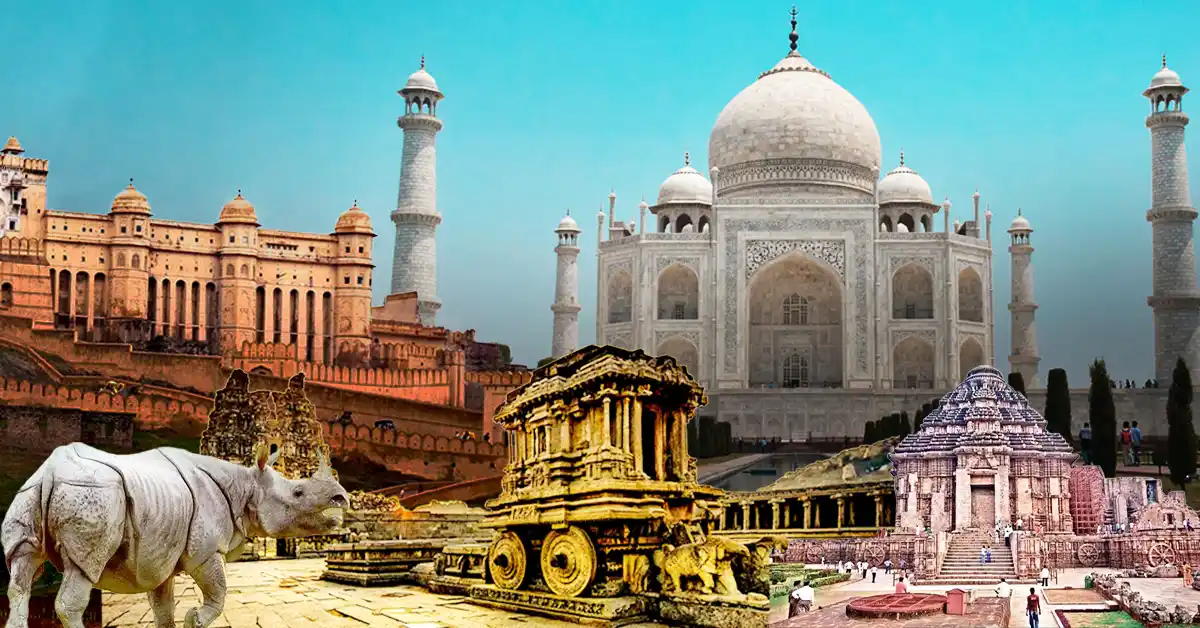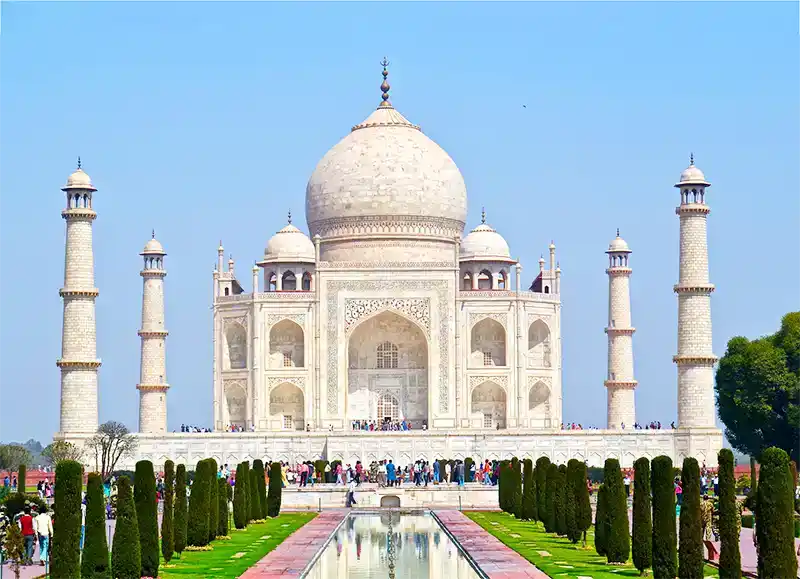UNESCO World Heritage Sites in India | Updated List 2025
India is the 7th largest country by land area and the most populous nation in the world. It is home to a highly diverse population, with hundreds of languages, communities, and traditions. The country’s geography ranges from the Himalayan mountains to coastal beaches, from dense forests to deserts, making it one of the most varied landscapes on Earth. There are many remarkable UNESCO World Heritage Sites in India that reflect the country’s rich history, culture, and natural beauty.
Disclaimer
The information in this article is based on trusted sources, including the official UNESCO website, and is updated as of 2025. We have tried our best to give correct and complete details. However, the number of World Heritage Sites in India or their categories may change in the future. New sites may be added, and some information may be updated over time. For the most accurate and latest details, please check the official UNESCO website.
As of 2025, there are 43 UNESCO-listed sites in the country, including 35 cultural, 7 natural, and 1 mixed site. These places have global importance and highlight the diverse heritage of India. In this updated guide, we explore each site and understand why they are recognized by UNESCO.
Table of Contents
ToggleWhat Are UNESCO World Heritage Sites?
UNESCO stands for the United Nations Educational, Scientific and Cultural Organization. It is a global body that works to promote education, science, culture, and the protection of heritage.
A UNESCO World Heritage Site is a place that has special cultural, historical, scientific, or natural value. These sites are considered important for all of humanity, not just the country they belong to. They can include monuments, buildings, cities, forests, mountains, lakes, parks, or any location that is unique and worth preserving.
UNESCO gives this recognition to help protect these sites for future generations. Being listed often brings international attention, increases tourism, and helps with conservation efforts. The goal is to make sure these valuable places are maintained, respected, and not lost over time.
Benefits of Being a UNESCO World Heritage Site
Getting recognized as a UNESCO World Heritage Site brings many advantages, both for the site and for the country:
- Global Recognition: The site gains international importance and becomes known to people around the world. This helps spread awareness of its cultural or natural value.
- Tourism Boost: UNESCO status often attracts more tourists, both domestic and international. This can help local businesses and support the local economy.
- Funding and Support: The site may receive financial help, expert advice, and technical support from UNESCO and other international bodies for conservation and maintenance.
- Preservation and Protection: Being listed brings more attention to protecting the site. It encourages governments to take better care of it and create long-term plans for its safety.
- Educational Value: These sites are used as learning examples for schools, researchers, and tourists. They help educate people about history, architecture, nature, and heritage.
- Pride and Cultural Identity: It creates a sense of pride among local communities and strengthens their connection to cultural or natural history.
How a Site Becomes a UNESCO World Heritage Sites in India?
Not every historic or natural place gets added to the World Heritage list. There is a careful process to decide which sites deserve this global honour. Here’s how a place becomes one of the UNESCO World Heritage Sites in India:
- Nomination by the Indian Government: The Indian government first selects a site and sends a detailed proposal to UNESCO. This only happens if the site is already on India’s official Tentative List – a list of possible future World Heritage Sites.
- Expert Review: Once nominated, international experts review the site. UNESCO works with groups like ICOMOS (for cultural sites) and IUCN (for natural sites) to check the site’s importance and condition.
- Meeting UNESCO Criteria: To be chosen, a site must meet at least one of UNESCO’s ten criteria. These cover things like cultural value, natural beauty, historical importance, or uniqueness.
- Final Decision by UNESCO: After the evaluation, the World Heritage Committee meets to decide whether the site will be added to the list. If approved, it will become an official UNESCO World Heritage Site in India.
- Protection and Care: Even after being listed, the site must be protected. India has to take care of the site and send regular reports to UNESCO about its condition and any threats it might face.
How Many UNESCO World Heritage Sites in India?
As of March 2025, there are 43 UNESCO World Heritage Sites in India. These are special places chosen by UNESCO (United Nations Educational, Scientific and Cultural Organization) because they are valuable to all of humanity. Out of the 43 sites, 35 are cultural, 7 are natural, and 1 is a mix of both. These sites show India’s long history, deep traditions, and rich natural beauty.
India’s Global Position in World Heritage Sites
India ranks 6th in the world for having the most UNESCO World Heritage Sites. Countries like Italy, China, France, Germany, and Spain are ahead. Across the globe, UNESCO has listed over 1,200 such places.
These include ancient structures, unique landscapes, and places that are important both naturally and culturally. India adds new sites from time to time, showing its growing role in protecting global heritage.
Types of UNESCO World Heritage Sites in India
Cultural Sites (35)
Cultural sites highlight India’s history, art, religion, and architecture. These include old cities, temples, forts, and monuments that show how people lived and believed in the past.
Examples: Taj Mahal (Uttar Pradesh), Hampi (Karnataka), Sun Temple (Odisha)
- Natural Sites (7)
Natural sites are known for their wildlife, forests, and landscapes. These areas are protected for their beauty and biodiversity.
Examples: Kaziranga National Park (Assam), Sundarbans (West Bengal), Western Ghats (South India) - Mixed Site (1)
Mixed sites are special because they are important both culturally and naturally.
Example: Khangchendzonga National Park (Sikkim) — This park has rare animals, high peaks, and spiritual value for local communities.
List of UNESCO World Heritage Sites in India
Here is the detailed list of all 43 UNESCO World Heritage Sites in India, showing their type, location, state, and grouped by the year they were recognized.
| No. | Name of Site | Location (City) | State/UT | Year Inscribed |
|---|---|---|---|---|
| 1 | Agra Fort | Agra | Uttar Pradesh | 1983 |
| 2 | Ajanta Caves | Aurangabad | Maharashtra | 1983 |
| 3 | Archaeological Site of Nalanda Mahavihara | Nalanda | Bihar | 2016 |
| 4 | Buddhist Monuments at Sanchi | Sanchi | Madhya Pradesh | 1989 |
| 5 | Champaner-Pavagadh Archaeological Park | Champaner/Pavagadh | Gujarat | 2004 |
| 6 | Chhatrapati Shivaji Terminus | Mumbai | Maharashtra | 2004 |
| 7 | Churches and Convents of Goa | Old Goa | Goa | 1986 |
| 8 | Dholavira: a Harappan City | Dholavira | Gujarat | 2021 |
| 9 | Elephanta Caves | Mumbai | Maharashtra | 1987 |
| 10 | Ellora Caves | Aurangabad | Maharashtra | 1983 |
| 11 | Fatehpur Sikri | Fatehpur Sikri | Uttar Pradesh | 1986 |
| 12 | Great Living Chola Temples | Thanjavur | Tamil Nadu | 1987, 2004 |
| 13 | Group of Monuments at Hampi | Hampi | Karnataka | 1986 |
| 14 | Group of Monuments at Mahabalipuram | Mahabalipuram | Tamil Nadu | 1984 |
| 15 | Group of Monuments at Pattadakal | Pattadakal | Karnataka | 1987 |
| 16 | Hill Forts of Rajasthan | Chittorgarh, Kumbhalgarh, Jaipur, etc. | Rajasthan | 2013 |
| 17 | Historic City of Ahmedabad | Ahmedabad | Gujarat | 2017 |
| 18 | Humayun's Tomb | Delhi | Delhi | 1993 |
| 19 | Jaipur City | Jaipur | Rajasthan | 2019 |
| 20 | Kakatiya Rudreshwara (Ramappa) Temple | Mulugu | Telangana | 2021 |
| 21 | Khajuraho Group of Monuments | Khajuraho | Madhya Pradesh | 1986 |
| 22 | Mahabodhi Temple Complex at Bodh Gaya | Bodh Gaya | Bihar | 2002 |
| 23 | Moidams – the Mound-Burial System of the Ahom Dynasty | Charaideo | Assam | 2024 |
| 24 | Mountain Railways of India | Darjeeling, Ooty, Kalka-Shimla | (West Bengal, Tamil Nadu, Himachal Pradesh) | 1999, 2005, 2008 |
| 25 | Qutb Minar and its Monuments | Delhi | Delhi | 1993 |
| 26 | Rani-ki-Vav (Queen’s Stepwell) | Patan | Gujarat | 2014 |
| 27 | Red Fort Complex | Delhi | Delhi | 2007 |
| 28 | Rock Shelters of Bhimbetka | Raisen | Madhya Pradesh | 2003 |
| 29 | Sacred Ensembles of the Hoysalas | Belur, Halebidu, Somanathapura | Karnataka | 2023 |
| 30 | Santiniketan | Birbhum | West Bengal | 2023 |
| 31 | Sun Temple | Konârak | Odisha | 1984 |
| 32 | Taj Mahal | Agra | Uttar Pradesh | 1983 |
| 33 | The Architectural Work of Le Corbusier | Chandigarh | Chandigarh | 2016 |
| 34 | The Jantar Mantar | Jaipur | Rajasthan | 2010 |
| 35 | Victorian Gothic and Art Deco Ensembles of Mumbai | Mumbai | Maharashtra | 2018 |
| 36 | Great Himalayan National Park Conservation Area | Kullu | Himachal Pradesh | 2014 |
| 37 | Kaziranga National Park | Golaghat, Nagaon | Assam | 1985 |
| 38 | Keoladeo National Park | Bharatpur | Rajasthan | 1985 |
| 39 | Manas Wildlife Sanctuary | Baksa, Chirang | Assam | 1985 |
| 40 | Nanda Devi and Valley of Flowers National Parks | Chamoli, Pithoragarh | Uttarakhand | 1988, 2005 |
| 41 | Sundarbans National Park | South 24 Parganas | West Bengal | 1987 |
| 42 | Western Ghats | Multiple Locations | Maharashtra, Karnataka, Kerala, Tamil Nadu | 2012 |
| 43 | Khangchendzonga National Park | North Sikkim | Sikkim | 2016 |
UNESCO World Heritage Sites in India | Updated List 2025 - References
- UNESCO – India
- Wikipedia – List of World Heritage Sites in India
Additional Reading
For further reading on Trusted Facts on Travel, Health, Sports, Tech etc., consider the following:
- 10 Best Fruits for Weight Loss & How to Eat Them for Fast Results
- Top 10 Best-Selling Books of All Time in the World History
- Walking Palm Tree – The Amazing Tree in the Rainforests
- Future Inventions That Could Change the World Forever
- 8 Chiranjeevis in Hinduism – Immortals (Chiranjivi) and Their Significance






